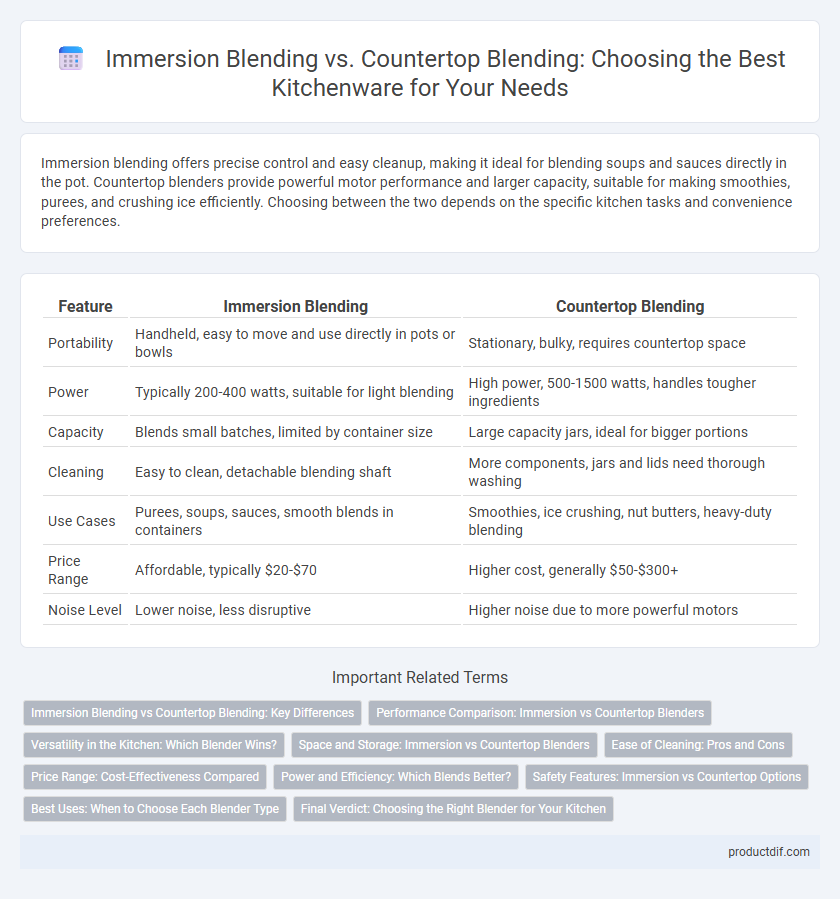Immersion blending offers precise control and easy cleanup, making it ideal for blending soups and sauces directly in the pot. Countertop blenders provide powerful motor performance and larger capacity, suitable for making smoothies, purees, and crushing ice efficiently. Choosing between the two depends on the specific kitchen tasks and convenience preferences.
Table of Comparison
| Feature | Immersion Blending | Countertop Blending |
|---|---|---|
| Portability | Handheld, easy to move and use directly in pots or bowls | Stationary, bulky, requires countertop space |
| Power | Typically 200-400 watts, suitable for light blending | High power, 500-1500 watts, handles tougher ingredients |
| Capacity | Blends small batches, limited by container size | Large capacity jars, ideal for bigger portions |
| Cleaning | Easy to clean, detachable blending shaft | More components, jars and lids need thorough washing |
| Use Cases | Purees, soups, sauces, smooth blends in containers | Smoothies, ice crushing, nut butters, heavy-duty blending |
| Price Range | Affordable, typically $20-$70 | Higher cost, generally $50-$300+ |
| Noise Level | Lower noise, less disruptive | Higher noise due to more powerful motors |
Immersion Blending vs Countertop Blending: Key Differences
Immersion blending offers hands-on control, portability, and easy cleanup, making it ideal for soups, sauces, and small batches. Countertop blenders provide more powerful motors and larger capacity, suitable for smoothies, frozen drinks, and heavy-duty tasks. The choice depends on desired versatility, ease of use, and blending volume in kitchenware applications.
Performance Comparison: Immersion vs Countertop Blenders
Immersion blenders provide precise control and convenience for blending directly in pots or bowls, offering efficient performance for small batches and quick tasks. Countertop blenders feature more powerful motors and larger capacities, excelling in processing tougher ingredients and larger volumes with consistent results. The choice depends on performance needs: immersion blenders are ideal for lightweight tasks, while countertop blenders deliver superior power and versatility for heavy-duty blending.
Versatility in the Kitchen: Which Blender Wins?
Immersion blenders excel in versatility by allowing precise control for blending directly in pots, bowls, and pitchers, making them ideal for soups, sauces, and small batches. Countertop blenders offer powerful, multi-speed motors capable of handling larger volumes and tougher ingredients like ice and frozen fruits, suitable for smoothies, purees, and crushing tasks. For kitchens prioritizing versatility, immersion blenders provide seamless integration in cooking processes, while countertop blenders deliver broader capabilities for diverse culinary preparations.
Space and Storage: Immersion vs Countertop Blenders
Immersion blenders offer a compact design ideal for limited kitchen spaces, easily stored in drawers or hung on hooks without occupying countertop area. Countertop blenders, while bulkier and requiring dedicated counter or cabinet space, typically provide larger blending capacities and more powerful motors. Choosing between immersion and countertop blenders depends on balancing the need for space-saving convenience against blending performance and storage availability.
Ease of Cleaning: Pros and Cons
Immersion blenders offer superior ease of cleaning due to their detachable blending shaft, allowing quick rinsing and dishwasher-safe components. Countertop blenders often feature multiple parts, including a heavy jar and lid, which require thorough disassembly and careful cleaning to avoid clogging and odor retention. While immersion blenders minimize cleanup time for quick tasks, countertop blenders may demand more effort but can accommodate larger food quantities.
Price Range: Cost-Effectiveness Compared
Immersion blenders typically range from $20 to $100, offering a cost-effective option for quick blending tasks and small batches, making them ideal for budget-conscious buyers. Countertop blenders, on the other hand, vary between $50 and $500, with powerful motors and versatile features justifying the higher price for frequent use and larger quantities. Evaluating specific models helps balance cost against functionality, ensuring optimal kitchenware investment based on blending needs.
Power and Efficiency: Which Blends Better?
Immersion blenders typically feature motors ranging from 200 to 600 watts, offering precise control for small to medium blending tasks, while countertop blenders often boast powerful motors between 500 to 1500 watts, designed for heavy-duty efficiency and processing larger quantities more quickly. Countertop blenders deliver superior blending power, enabling smoother textures for tougher ingredients such as ice, nuts, and fibrous vegetables, making them ideal for smoothies and purees. Immersion blenders excel in convenience and versatility for quick blending in pots or pitchers but may struggle with dense or large-volume blending compared to the robust performance of countertop models.
Safety Features: Immersion vs Countertop Options
Immersion blenders feature a compact, handheld design with a retractable blade guard that minimizes accidental contact, enhancing user safety during blending tasks. Countertop blenders often include locking lids, non-slip bases, and automatic shutoff mechanisms to prevent spills and motor overheating. Both options prioritize safety differently, with immersion blenders offering more control and portability, while countertop models provide built-in protective features for heavy-duty use.
Best Uses: When to Choose Each Blender Type
Immersion blenders excel in small-batch blending, soups, sauces, and quick purees directly in pots or containers, offering convenience and easy cleanup. Countertop blenders are ideal for larger volumes, smoothies, crushing ice, and more complex recipes requiring powerful motors and variable speeds. Choosing an immersion blender suits quick tasks and minimal space, while countertop blenders fit heavy-duty blending and multitasking in the kitchen.
Final Verdict: Choosing the Right Blender for Your Kitchen
Immersion blenders offer compact design and easy maneuverability for quick tasks like pureeing soups and sauces, while countertop blenders provide powerful motors and larger capacities suited for smoothies, frozen drinks, and heavy-duty blending. Selecting the right blender depends on your kitchen space, blending frequency, and the types of recipes you prepare most often. Consider immersion blenders for convenience and portability, or opt for countertop blenders to handle diverse, high-volume blending needs efficiently.
Immersion blending vs Countertop blending Infographic

 productdif.com
productdif.com